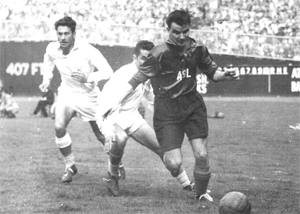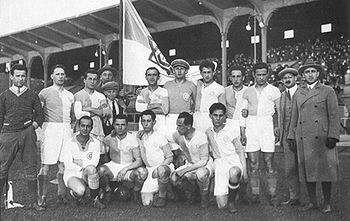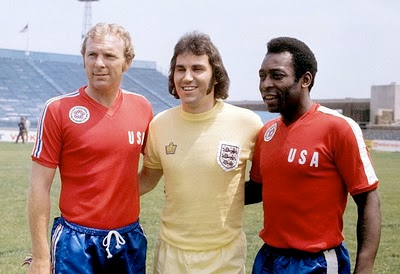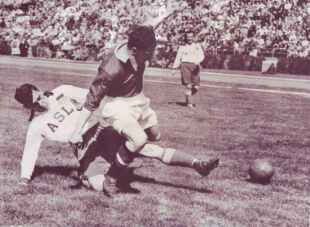Featured image: ASL All-Stars play Manchester United to a 2-2 draw at Randalls Island in New York on May 17, 1950. Photo courtesy of soccerreform.us.
Tonight we will once again by subjected to the MLS All Star Game—the annual, mid-season distraction that, quite frankly, often feels like the last vestige of “Americanization” foisted upon the Beautiful Game by MLS 1.0. The Shootout is gone, names like “Clash” and “Wiz” are but painful memories, and the game clock no longer counts down…but we still have this match, currently pitting MLS stars against a top foreign club—albeit one in pre-season form.
It is interesting that MLS persists in having this match. After all, even the original North American Soccer League–the league of 35-yard lines, 6 points for a win, and (ugh) cheerleaders–didn’t bother with one (although the latter-day American Soccer League did). Yet, have it they must.
While I personally do not care for the All-Star Game, apparently quite a few people do. So it if for those folks that I’ll submit the following, establishing that—my cynicism notwithstanding—the concept of an all-star game is not something clumsily grafted on American soccer but, surprisingly, is one that has been part of a long footie tradition on these shores.
The rise of the All-Star Game tradition
Most people know that, in America, the all-star game concept was popularized by major league baseball. The first midsummer classic was held in 1933; however, the “all-star” idea had been employed by ballplayers during off-season barnstorming tours, and in 1920 players held an all-star “testimonial” game for the family of Ray Chapman, the Cleveland Indians shortstop who had died in an on-field beaning incident that season.
An instant smash (largely because it was the only time players from the National and American Leagues could face one another, outside of the World Series—the anticlimactic interleague play we have today is a fairly recent construct), the other major sports soon followed: the National Football League’s first all-star game was held in 1939, the National Hockey League had its first in 1947 (although, a la the Chapman benefit, NHL players had staged earlier all-star games to benefit players like Ace Bailey (1933), Howie Morenz (1937), and Babe Siebert (1939)), and pro basketball finally got around to one in 1951.
Soccer All-Star Games in the 1920s
Alas, major league soccer in the United States had collapsed by 1933—the original American Soccer League was gone, drowned in a sea of red ink caused by both the Great Depression and a debilitating “Soccer War.” However, the ASL itself employed the all-star concept, and in the same fashion as currently used by MLS: league all-stars would band together for one-off matches against visiting sides.
In 1926, the legendary Vienna Hakoah team visited the U.S. The exemplars of the “muscular Judaism” school of the era, Hakoah were champions of Austria in 1924-25. Made up entirely of Jewish players, Hakoah drew huge crowds wherever they played. The club’s 7-game tour found them facing various ASL teams, including Philadelphia FC, whom they beat 3-nil before 25,000. (Click here for more on Philadelphia soccer and the international friendly.)
The highlight of the tour was a May 1, 1926 exhibition game between Hakoah and the “New York Stars,” a team featuring the best of the ASL’s New York Giants and Indiana Flooring (the sponsor’s name—the team was based in New York). Playing before 46,000 fans in the Polo Grounds in New York, the hosts defeated the visitors, 3-0. Pete Renzulli of New York Giants, the backup goalkeeper for the team, remembered that Hakoah “had the ball for 87 minutes,” but that the ASL scored three times on counterattacks.
In spite of the crowds, the tour was still a financial failure for Hakoah, probably because many of the attendees for their games got in with free tickets; the club reported that it lost over $30,000 and, as a result, the club’s president resigned upon his return to Vienna. The team also lost players, as a number of Viennese stars jumped to play for Brooklyn Wanderers and New York Giants (two teams with Jewish owners). Hakoah’s influence on the game here would be considerable, however; professional and semi-professional teams bearing the “Hakoah” name would dot the American soccer landscape for years to come.
The ASL’s first “full” all-star team was assembled in 1927. That year, the Uruguay National Team—Olympic champions in 1924 and destined to win the Olympic gold medal in 1928 and the first World Cup in 1930—toured the U.S. and played a 9-game schedule. On May 28, 1927, the Uruguayans defeated Philadelphia FC 3-1 before 10,000 at Sesquicentennial Stadium (later Municipal Stadium and, still later, JFK Stadium—the First Union Center currently occupies its footprint). About two months’ earlier, however, Uruguay faced the ASL All-Stars before 10,000 at the Polo Grounds in New York. The visitors won the match, 4-2; both ASL goals came from Sam Kennedy of Fall River Marksmen.
The next year found Glasgow Rangers visiting the U.S., playing 10 games against both ASL and semi-professional teams. On June 23, 1928, the Rangers faced the ASL All-Stars at Ebbets Field in Brooklyn, NY. About 10,000 watched the Scotsmen thrash the ASL select team, 6-0. Brooklyn Wanderers’ Steve Smith—himself a native of Aberdeen—was the unfortunate goalkeeper that day.

Undated photo of Philadelphia-born National Soccer Hall of Famer Benny McLaughlin (in dark uniform) with the ASL All-Stars.
Soccer All-Star Games in the semi-pro era
Even after the collapse of the first ASL, its semi-pro successor continued the All-Star tradition. In fact, the second ASL relied heavily on foreign tours to remain financially solvent, hosting games between international powers that would draw crowds of over 40,000 to the Polo Grounds and Ebbets Field. Occasionally, these teams would face ASL select squads. Some examples include games against Liverpool (twice in 1946—both losses); Liverpool again in 1948 (a 9-2 thrashing); the Israeli National Team in 1948 (a 3-2 win for the ASL in Brooklyn); the Scottish National Team in 1949 (a 4-1 loss at Randalls Island in NY); and Inter Milan in 1949 (a 5-nil drubbing at Randalls Island).
In 1950, an ASL All-Star team made up of Kearny, NJ/Philadelphia-based players played Manchester United to a 2-2 draw at Randalls Island. From the league champion Philadelphia Nationals on the ASL team were future National Soccer Hall of Famers Ed McIlvenny, Walter Bahr, Benny McLaughlin and Nick Kropfelder.
Soccer All-Star games in the 1970s
Although all-star matches against touring sides dwindled considerably through the 1950s and 1960s—no doubt because of the lack of ASL competitiveness in such matches—the league brought the concept back in 1979. That year saw an inter-league match, pairing stars from the different divisions against one another. In 1980, the ASL All-Stars were pitted against a visiting foreign side. In 1981, the ASL All-Stars played against league club Detroit Express, featuring guest player Trevor Francis (a star with the Express in 1978 and 1979, when they were still playing in the NASL). Over 14,000 attended in the Pontiac Silverdome to watch the All-Stars defeat the Express, 2-0. Francis had five shots, but failed to score. In 1982, the ASL All-Star Game was a featured event at the World’s Fair in Knoxville, Tennessee.
Finally, an honorable mention should be bestowed upon the 1976 Bicentennial Cup, a tournament hosted by the NASL pitting national team sides against “Team America”–made up of NASL all-stars, regardless of country of origin. Although U.S. players (and ex-Philadelphia Atoms) Bob Rigby and Bobby Smith were on the team, the rest of the roster included such famous (albeit aging) names as Pele, Bobby Moore, and Mike England. Establishing a tradition that players in other sports have since followed, “all-stars” George Best and Rodney Marsh were “injured” (read: “decided they had better things to do, and stayed home”).
Team America lost its matches against Italy, Brazil, and England. On May 31, 1976, they played England in front of 16,231 at JFK Stadium in what would be the last pro soccer all-star game in Philadelphia until the Union hosted the MLS All-Star Game in 2012. Philadelphia soccer fans witnessed Team America scored their only goal of the tournament in the 3-1 loss, courtesy of Stewart Scullion. Brazil walked away as tournament winners.
Love or hate the All-Star Game…but at least it is an American soccer tradition.




http://www.sm-jia.com/forum.php?mod=viewthread&tid=219609&fromuid=44019